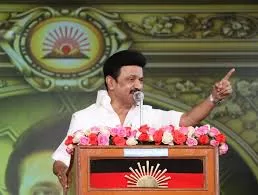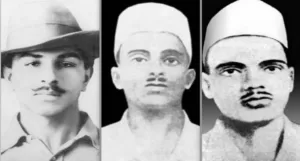❈ ❈ ❈
Tamil Nadu is BJP’s Toughest Test Against Cultural Uniformity
Saba Naqvi
It is hard to believe there is something in common between a stated desire to demolish the tomb of the Mughal Emperor Aurangzeb in Maharashtra and an education policy that is seen by critics as a means to promote Hindi in Tamil Nadu and other non-Hindi-speaking States. But these are two sides of the same coin—an ideological thrust that seeks to flatten the curves in Indian identities into one uniform nation where diversity could be interpreted as a threat to national integration, and faith assertion is occasionally about hammering living people in the larger cause of settling historical grievances of the past.
Hindutva and majoritarianism are constructs that seek to squeeze round pegs into one square hole and, in some instances, have succeeded—with considerable spillage. If Kashmir to Kanniyakumari is one vision of the length of the nation, then certainly Kashmir on the northern end has been flattened—from being part of a full State with a special status to a Union Territory barely enjoying a constrained form of electoral politics. Tamil Nadu in the southern extreme poses the greater challenge.
The State, with its distinct political history and its big metropolises and industrial zones, has economic indices that are way better than those of BJP-ruled Hindi heartland States and, hence, can hold its ground. It is currently doing so with its loud and clear opposition to the imposition of three languages through the National Education Policy 2020. That pushing too hard by the Centre can have unforeseen consequences is seen in the manner in which Tamil Nadu Chief Minister M.K. Stalin released a promotional logo for the State Budget in which the Indian currency symbol was replaced by one in Tamil script. Union Ministers described this as “promoting secessionism”, while the Dravida Munnetra Kazhagam (DMK) said it conveyed inclusiveness.
An ideological, economic and political conundrum
Tamil Nadu poses a conundrum to the BJP-RSS combine that is ideological, economic, and political. First, if there is one ideological construct that is yet to be defeated in BJP-dominant India, it is the Dravidian template rooted in rationalism, social justice, and regional pride. It challenges Hindutva both as a political strategy and a cultural ethos. Indeed, if we examine unconquered territories, then Tamil Nadu seems to be the greater challenge in south India where the BJP is not currently in power in any State. In Karnataka, the BJP is a former ruling party and can, logically, return to power as it has struck roots in the State.
There is also potential for the BJP to grow in Telangana, while it is aligned with regional formations in Andhra Pradesh that are not rooted in any particular ideology. There is also a genuine RSS fantasy of prevailing in Kerala one day, riding on a reaction to the State’s large and distinct, even if still a minority, Muslim population. Kerala’s Christians are being cultivated as allies to make that dream come true.
But it is in Tamil Nadu where the BJP has apparently hit a brick wall as, until now, there is a strong resistance in the State to attempts at cultural homogenisation. The BJP in the Modi era has functioned through various regional parties, but all the hype and gushing media campaigns about its Tamil Nadu president K. Annamalai amounted to zilch in 2024. Of course, the BJP has a small vote share here, but it is not clear what its prospects or strategy can be. Tamil Nadu has an Assembly election coming up next year, and it makes sense for the ruling DMK-led alliance to take the lead in asserting its distinctness and cultural power. The standoff also comes at a time when the threat of delimitation hangs over States that have performed well in population control and against a backdrop of constant curtailing of federal powers by the Centre.
Vision of a religious state versus Tamil Nadu’s proud rationalism
There are other layers to Tamil Nadu being an ideological frontier for the BJP. Juxtapose DMK leader Udhayanidhi Stalin’s derogatory remarks in 2023 about Sanatana Dharma (which translates as eternal religion or eternal order) with the BJP’s vehement support for this particular term. Contrast, too, the history of Tamil politics with the popular images put out by BJP leaders, be it of inaugurating temples and religious corridors or leading mass worship at the Mahakumbh. It conjures up images of a religious state with a metaphorical king, deity, and priest against Tamil Nadu’s proud rationalism.
In the decades after Independence, India was seen across the world as not just a democracy that was multilingual and the largest in the world, but a successful multi-faith state that was home to the world’s second-largest Muslim population. That image lies shattered as elected BJP politicians now project the Muslim minority as an eternal enemy, from the past to the present and certainly into the future. The Leader of the Opposition in West Bengal (where elections are due next year) was recently quoted as having said that if the BJP came to power in the State, the party would throw Muslim MLAs out of the Assembly.
A double-pincer attack on Muslims
For Indian Muslims there is a double-pincer movement: structured campaigns to keep alive their image as villains from the past while removing their names from electoral rolls in the present. This has been reported in some detail in many BJP-ruled States during elections. In the project of realising a Hindu state, it is also now a rite of passage for Muslim homes to be demolished and for Hindutva’s foot soldiers to dance before mosques during Hindu festivals while playing Hindutva pop and raising shrill anti-Muslim slogans.
The state as envisioned by proponents of Hindutva thrives on the creation of adversaries. This is not unique to India and characterises right-wing ideologies across the world. In the perpetuation of this reality, the real genius of India is sadly forgotten. Indian democracy is a remarkable feat of languages where a Member of Parliament can address the House in 22 constitutionally recognised languages that have their own scripts, literature, cinema, and music. Look at a currency note, and see the number of scripts in which the denomination is written.
This happens nowhere else, unless we compare India to the entire European Union where institutions operate in 24 languages (India would actually cross that figure if its dialects were included). Indian democracy, therefore, unfolds across many tongues—from fiery speeches in Tamil to passionate debates in Bengali, from Manipuri chants at protest marches to an Urdu couplet being occasionally lobbed in Parliament—on all sides of the ideological divide.
The BJP and RSS seek to forge a uniform nation. The problem arises when they confront the multiplicity of languages and cultures in which India speaks.
(Saba Naqvi is a Delhi-based journalist and author of four books who writes on politics and identity issues. Courtesy: Frontline magazine, a fortnightly English language magazine published by The Hindu Group of publications headquartered in Chennai, India.)
❈ ❈ ❈
The Battle Between Hindutva and Dravidian Nationalism is Ideological, Not Electoral
Sarayu Pani
The Union government’s latest attempt to deny funds to Tamil Nadu under the RTE Act for their failure to comply with the “three language formula” and introduce Hindi in schools is a fascinating reminder of how linguistic politics in Tamil Nadu remains a thorn in the side of Hindutva – unlike many other linguistic and regional assertions in the country that have dovetailed quite neatly into Hindu majoritarianism.
In the 1980s, the Gokak agitations in neighbouring Karnataka were the largest protest against the three language formula at the time. Beginning in intellectual circles, and led by the leading Kannada writers of the time, the movement attained mass status once it was supported by the Kannada film industry. And yet, Gokak did not really create a change in the nature of Kannadiga identity that outlived the movement. Without this grounding, the mass politics aspects of the language movement in Karnataka were soon reduced to being a convenient tool to wield against any group being politically targeted at the time.
By the early 1990s, for example, the same linguistic politics that had driven the Gokak agitation were being used both communally, in the form of the 1994 anti-Urdu riots and to protest Cauvery water allocations. In Maharashtra, the Shiv Sena began with the politics of Marathi linguistic assertion, before shifting towards Hindutva.
Scholars agree that identities are not an automatic or inevitable outcome of cultural differences. This is true for linguistic identity as well. The objective fact of sharing a language is not usually sufficient to create an identity. The creation of a linguistic identity involves an element of choice – sufficient members of the group must be seen speaking that particular language as essential or critical to their identity. The movements that create this consensus, and the terms on which such consensus is created, then become the politics of that identity.
Linguistic or regional assertions within the subcontinent therefore differ quite widely from each other, based on how the identity in question came into being in its modern form. These differences also shape how these movements respond when they come into contact with larger nationalist ideologies – whether Nehruvian nationalism or more recently, Hindutva.
Understanding why Tamil linguistic assertion remains both successful against Hindi imposition (Tamil Nadu remains the only state that has never included Hindi in schools) and relatively immune to the pull of Hindutva lies in its roots – Dravidian nationalism organised around the twin rejections of Brahmanism and the related linguistic influence of Sanskrit.
Dravidian movement
When the South Indian Liberation Federation (later named the Justice Party) was founded in 1916 in the Madras Presidency, its stated aim was to render social justice to the non-Brahmin caste groups. But while the Dravidian movement is often spoken of today as an anti-caste movement, it is perhaps better understood as nationalist movement. And while the demand for separate nation was dropped in the 1950s, the essential thrust of Dravidian politics, including a recent claim about the origins of the Iron Age, remain civilisational distinctness from what is described as the Aryan north. Both the linguistic and the caste justice aspects of this movement are intricately linked to this.
In the Dravidian narrative, non-Brahmins in Tamil Nadu were identified racially and culturally as Dravidian while Brahmins were seen as Aryan, and originating in north India. The caste system was therefore challenged as an Aryan imposition and Dravidians were asked to disregard caste based notions of pollution, segregation and rank. Further, sanskritic scriptural tradition was challenged and the role of Brahmins in rituals like marriages or funerals was rejected in favour of ceremonies solemnised by community elders.
Like all budding nationalisms of the time, the Dravidian movement also focussed on first declaring its sovereignty in the cultural domain, specifically in the domain of language. And if Sanskrit, and its modern north Indian derivative, Hindi, were seen as the languages of the Aryan, Tamil was portrayed as the ancient (and uncorrupted) language of the Dravidian. By the end of the 19th century, several ancient Tamil texts began to appear in print. These classics, including the legend of Kannagi, a Tamil goddess of chastity, and texts like Thirukkural provided the foundations for a literary tradition that would lay claim to an ancient culture, independent of Sanskrit, whose custodians would be non-Brahmins.
Hindi imposition in this ideological framework (first attempted in 1937) was seen as an extension of the sanskritic scriptural tradition and consequently as a form of religious and political bondage to the politics of northern India, and its Brahmanism.
Mass intellectualism
While the Dravidian movement under the Justice Party was originally filled with somewhat elite and wealthy non-Brahmins, E.V. Ramaswamy (“Periyar”) was to change that. Periyar attracted non-Brahmins from a far more diverse class spectrum, who were drawn to his promise of restoring pride and dignity to the non-Brahmin youth.
The politics of Periyar’s Self Respect Union was not limited to criticisms of Brahmanism. It involved the organisation and dissemination of an independent Tamil history and culture untouched by Sanskrit. The Self Respect Union became a training ground for an entire generation of thinkers, writers and public speakers who would then go on to articulate a comprehensive system of Tamil thought, myth, morality, ritual and values culled from the ancient Tamil texts, and communicate this system to the masses – initially through their hugely popular public speeches and writing, and later through the medium of film.
The masses in this form of Tamil cultural education were not limited to being passive recipients of information. For example, primary school teachers, who were themselves often literate only in Tamil, were at the forefront of spreading Dravidian ideology in the villages. This long tradition has meant that unlike linguistic assertions in many other states, the ideological commitment to Tamil runs well beyond specific triggers or flashpoints, like migration.
Decolonisation, language and Hindutva
Understanding the Dravidian movement as a nationalist movement with roots as old as anti-colonial nationalism is important to decipher why the argument of Hindi as essential to decolonisation repeatedly fails to land in Tamil Nadu.
Elsewhere in the subcontinent, overall control of the anti-colonial national movement remained quite predominantly upper caste. Indian nationalists saw replacing English with Hindi as essential to cultural decolonisation. While there were some internal differences between nationalists on the type of Hindi (or Hindustani) to be enforced, or the method of its enforcement, it was pretty generally agreed that dispensing with English as a link language was critical to decolonisation.
While this thinking found some takers in other southern Indian regions, in the Dravidian movement, liberation from Brahmin hegemony (and its linguistic tool, Sanskrit) took precedence over liberation from British colonialism, which was seen as something that could be dealt with after the dismantling of Brahmin hegemonies. In 1937, when Congress chief minister C. Rajagopalachari attempted to make Hindi compulsory in schools, Periyar himself organised the opposition. This gained the Dravidian movement considerable support from the student community.
Post independence, the Nehruvian approach to Hindi imposition (often handicapped by his own technocratic approach to governance, which was far more easily accomplished in English) was to make repeated (and often ignored) suggestions, reflected in a series of education policies dating back to the 1960s. Regional assertions were quelled and absorbed back into the nationalist fold with a policy of ad hoc linguistic concessions (such as the reorganisation of states) and generally letting sleeping issues lie.
This most recent Bharatiya Janata Party (BJP) attempt to hammer Hindi into Tamil Nadu using financial pressure demonstrates a far greater urgency and also a tacit recognition by the BJP that Dravidian nationalism and Hindutva cannot electorally co-exist.
While the electoral base of Hindutva today has unquestionably moved beyond its original upper caste bastions to include OBCs and Dalits, its ideologies remain distinctly Brahmanical. The focus on sanskritic civilisation, on cow slaughter prohibitions and on upper caste practices like vegetarianism and ritual purity – is core to the ideology. While the oppressed castes are allowed to participate as enforcers of these values – as voters, as members of cow slaughter vigilante groups or to enact “love jihad” vendettas against Muslims or Dalits – the ideology is still set and located in what Christophe Jaffrelot terms upper-caste orthopraxy.
This is the ideological battle which is being enacted in Tamil Nadu today. While it seems clear that the BJP, for all their bluster, does not expect Hindi in schools to be a winning electoral platform in the near future, their willingness to put it on the agenda indicates that they see that the long term future of Hindutva in Tamil Nadu depends on the dismantling of Dravidian nationalism. Hindi is only the first salvo.
(Sarayu Pani is a lawyer by training. Courtesy: The Wire, an Indian nonprofit news and opinion website. It was founded in 2015 by Siddharth Varadarajan, Sidharth Bhatia, and M. K. Venu.)




